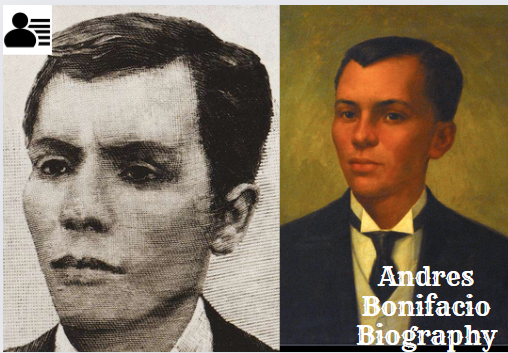
Advertisements
Andres Bonifacio Biography – Andres Bonifacio y de Castro, synonymous with the Philippine struggle for independence, remains one of the most revered figures in history. Born November 30, 1863, Bonifacio’s indomitable spirit and unwavering dedication to his country’s freedom have immortalized him as a national hero. This comprehensive biography looks into the life, contributions, and legacy of Andres Bonifacio, exploring his personal background, revolutionary activities, and ultimate sacrifice for the Philippine cause.
Andres Bonifacio Early Life and Background
Andres Bonifacio was born in Tondo, Manila, to Santiago Bonifacio and Catalina de Castro. His upbringing was marked by hardships, particularly after the early deaths of his parents, which forced him to shoulder the responsibility of supporting his younger siblings. Despite these challenges, Bonifacio was determined to educate himself. He worked various jobs as a warehouse clerk to sustain his family and fund his self-education.
Andres Bonifacio Full Name and Nickname
Andres Bonifacio’s full name is Andres Bonifacio y de Castro. He is often referred to by his nickname, “Maypagasa,” which means “The First President of the Republic of the Philippines.” This moniker highlights his pivotal role in the country’s quest for independence and his vision for a free Philippines.
Andres Bonifacio Contributions to the Philippine Revolution
Bonifacio’s most significant contribution to the Philippines was his founding of the Katipunan, a secret revolutionary society dedicated to overthrowing Spanish colonial rule. Established in 1892, the Katipunan aimed to unite Filipinos in the fight for freedom. Under Bonifacio’s leadership, the organization increased, amassing an estimated 100,000 members by August 1896.
When the Spanish authorities discovered the existence of the Katipunan, Bonifacio did not hesitate to call for an armed rebellion. This marked the beginning of the Philippine Revolution, with Bonifacio at the forefront, leading the charge for independence. His courage and strategic acumen were instrumental in the early successes of the revolutionary movement.
Andres Bonifacio Age, Wife, and Siblings – Personal Life
Andres Bonifacio was just 33 years old at the time of his death. His life was marked by personal tragedies and triumphs, including his marriages. His first wife, Monica, a neighbour from Palomar, died of leprosy. Later, Bonifacio met Gregoria de Jesus when he was a 29-year-old widower. Gregoria became his second wife and an ardent supporter of the revolutionary cause.
Bonifacio had three brothers and two sisters. His brothers were Ciriaco, Procorpio, and Troadio, while his sisters were Espiridina and Maxima. The bond with his siblings was strong, and they often supported him in his revolutionary endeavours.
Andres Bonifacio Death
Andres Bonifacio’s revolutionary activities eventually led to his downfall. In 1897, internal conflicts within the revolutionary ranks culminated in Bonifacio’s arrest. He was charged with sedition and treason by his rivals and was executed on May 10, 1897, in Maragondon, Cavite. Bonifacio’s death at the age of 33 was a tragic end to a life dedicated to the pursuit of Philippine independence.
Bonifacio’s Legacy and Final Words
Despite his untimely death, Andres Bonifacio’s legacy endures. He is remembered as “The Father of the Philippine Revolution” and a national hero whose efforts paved the way for the eventual independence of the Philippines. His final words, “Long live the Philippines,” encapsulate his unwavering patriotism and enduring hope for his country’s future.
FAQs
1. Who is Andres Bonifacio? Andres Bonifacio y de Castro was a Filipino revolutionary leader known as the Father of the Philippine Revolution. He founded the Katipunan and played a crucial role in the fight for Philippine independence from Spanish colonial rule.
2. How did Andres Bonifacio contribute to the Philippine Revolution? Bonifacio founded the Katipunan, a secret society that initiated the Philippine Revolution. His leadership and strategic planning were vital in organizing and leading the revolt against Spanish colonial authorities.
3. What were Andres Bonifacio’s last words? Andres Bonifacio’s last words were, “Long live the Philippines.”
4. How old was Andres Bonifacio when he died? Andres Bonifacio was 33 years old at the time of his death.
5. Who was Andres Bonifacio’s wife? Andres Bonifacio had two wives. His first wife, Monica, died of leprosy. His second wife was Gregoria de Jesus, whom he met when he was 29.
6. What was Andres Bonifacio’s nickname? Andres Bonifacio was nicknamed “Maypagasa,” which means “The First President of the Republic of the Philippines.”
Conclusion
Andres Bonifacio’s life is a testament to the power of resilience, courage, and unwavering dedication to one’s country. His contributions to the Philippine Revolution laid the groundwork for the nation’s eventual independence. Remembered as a national hero, Bonifacio’s legacy inspires future generations of Filipinos to fight for freedom and justice. His story serves as a poignant reminder of the sacrifices made by those who came before us, ensuring that the Philippines remains a free and sovereign nation.

Leave a Reply